For many children of the 1970s like myself who remember that final decade when affordable British, Italian, and German 2-seaters with ragtops could still be purchased new in the U.S., the phrase “sports car” conjures up distinct memories of them. I’m referring to the MGs, Triumphs, Fiat 124 Spiders, rear-engine Volkswagen Karmann Ghia & Beetle convertibles, and others that were on the roads in droves because their main appeal was affordable fun, reliability be damned. All of those models mentioned, by the way, bit the dust about 1980 once target customers began realizing they could have reliable Hondas and Toyotas for the same price. Of course, there were Mercedes SLs, Jaguar XKs, Porsche 911s, and Alfa Romeo Spiders for the well-to-do that continued on, keeping the 2-seat sports car tradition alive, but they weren’t as widespread.
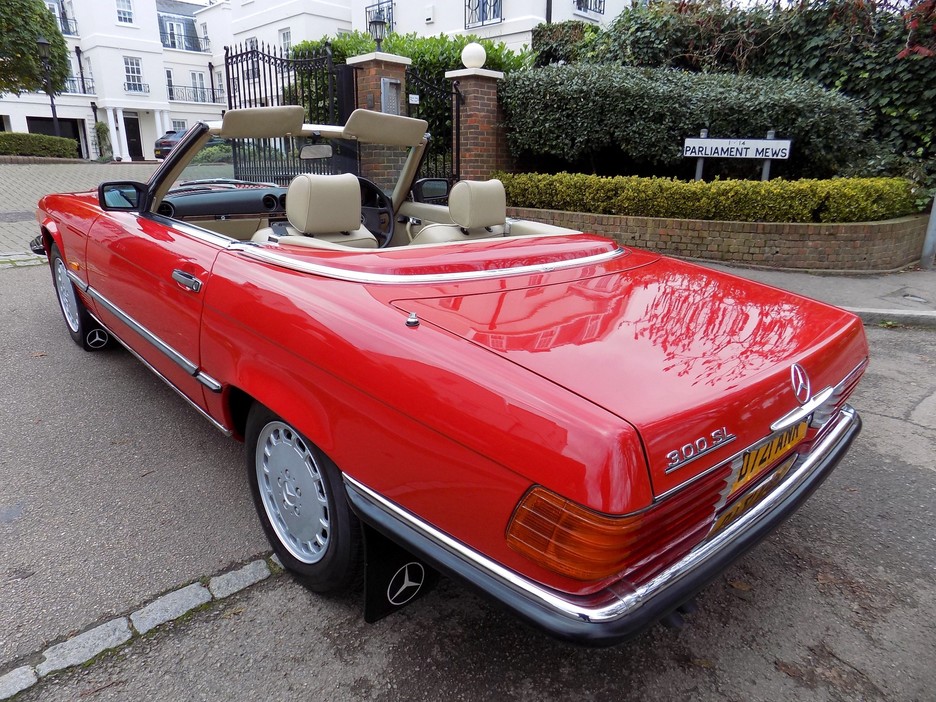
I’ve never owned this type of car, but would not mind having one to enjoy before get too old to drive. Thinking about it, I realized what I’d really like is a new, modern version of such a car packed with modern levels of comfort, technological convenience, performance, and built-in crash protection.
As other car fanatics have done for ages, I’ve often enjoyed imagining a small, two-seater with a convertible top and manual transmission parked between a luxury sedan and sport utility vehicle inside the 3-cars-wide garage of a house I’d love to own. Because it’s a vehicle that would only see use once in awhile on nice days, it doesn’t need to be practical. It doesn’t necessarily have to be a two-seater either, but it must be a two-door ragtop in bright midlife-crisis-red, if for no other reason than red has always been a favorite color. And, not to be forgotten, it absolutely must have a manual transmission – ya know, for fun and and for theft protection.
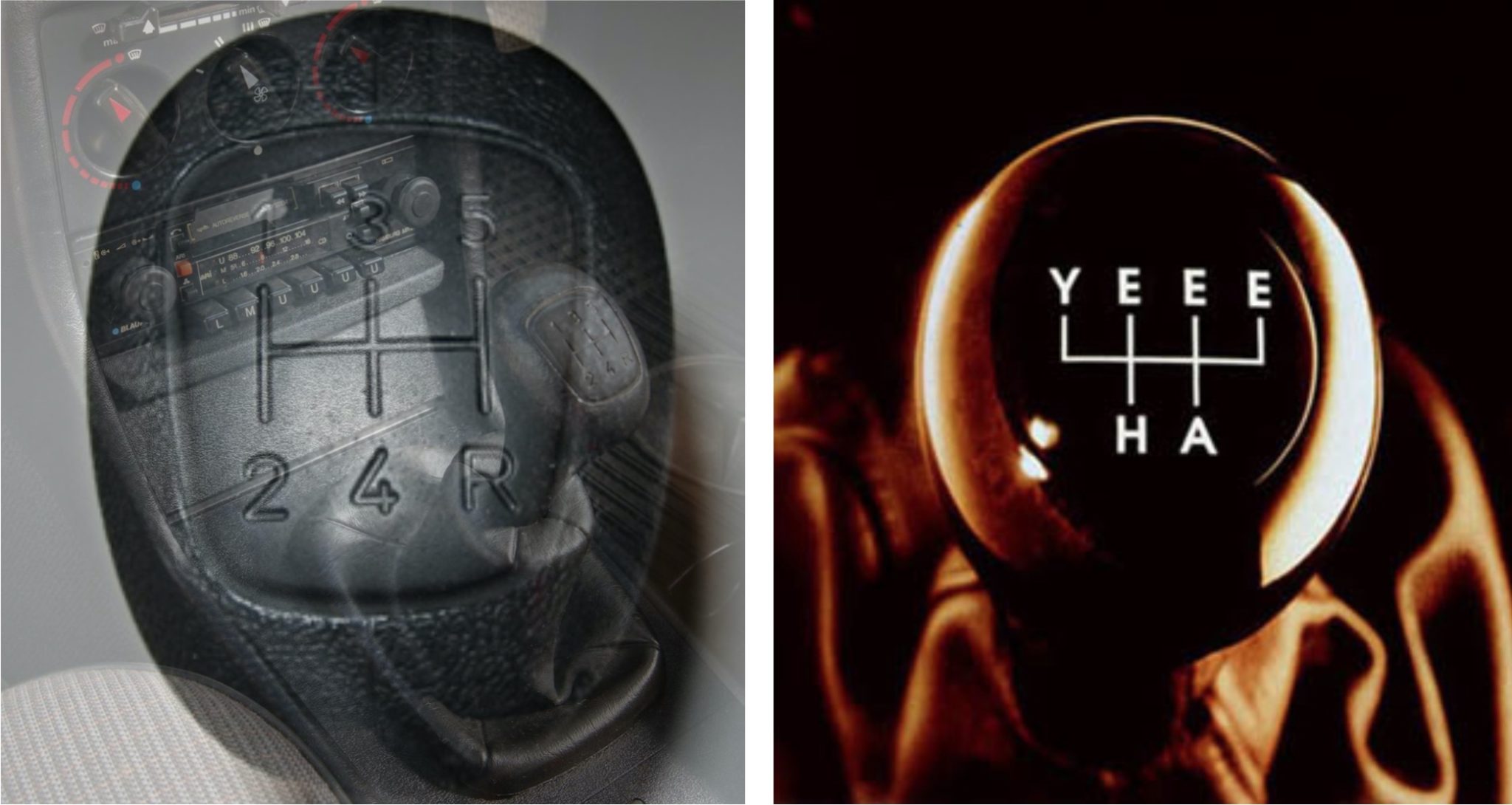
What actually got me thinking about the third-vehicle sports car concept was a recent vacation when I was presented with a few convertible choices at a rental car desk – specifically a Chevrolet Camaro, Ford Mustang, and Jeep Wrangler. Without much time to decide, I asked myself if the Camaro or the Mustang could potentially fill the role of “red sports car” for me in any way. They have rear seats and are bigger, but they are available as convertibles with manual transmissions.
When it came down to the realities of price, however, today’s supply-chain-limited market dictated that Jeep Wranglers were the least expensive of these choices to rent in Hawaii, so I chose a red 2-door that was available. I was curious to try a current “JL” generation Wrangler anyway because ride quality and refinement are supposedly up from the prior 2007-18 “JK” platform. The irony is, that selection ended up changing my opinion on what an enjoyable third sports car might be.
As my wife and I drove to our lodgings in the Wrangler rental, I began to wish I’d paid a little more and chosen the Mustang or Camaro – both of which are two-door convertibles I wouldn’t mind owning one bit. Bringing the red sports car concept up with my wife who, coincidentally, has never owned one but wants to, we reckoned together any such choice for our family would have to have a non-stratospheric price tag, ideally around $30,000. After realizing the only affordable 2-seat convertible choice in the United States is the Mazda Miata, she agreed the 2-seat requirement must be dropped in order to consider other choices that may exist.
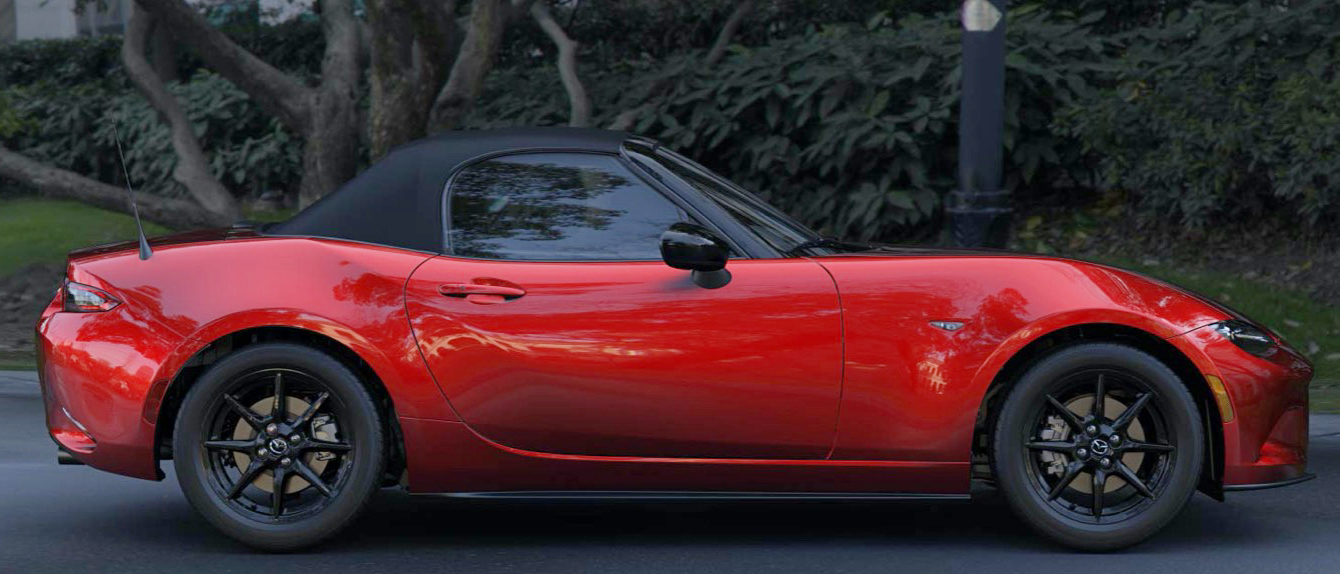
I’m starting with the Miata because I’ve always liked it for staying true to the classic definition of an open-top sports car. Having driven a first-generation ’96 Miata, I know they’re fun to drive because of their light weight and “tossability”.
The base MX-5 Miata (known as the “Sport” trim level) starts at $28,315 with delivery charge. All versions of the Miata feature a 2.0-liter, non-turbo engine producing 181 hp. A 6-speed manual is standard across the board, and red color selection adds $595. The interior features black cloth, which I would learn to live with because adding leather in various colors requires a package which, wouldn’t you know it, is only available on the highest, most expensive “Grand Touring” trim level of Miata. A NAV system with an easy-to-see screen seems well worth $400 in a sports car that will be used for touring the countryside and ending up in places that aren’t remotely familiar.
The $1,500 Appearance Package with front air dam and side sill extensions seems as unnecessary as the optional slim rear spoiler lip for $350. This car won’t be travelling at the kind of Mach 1 speeds needed to make these spoilers functionally useful, so I’ll pass on them. With delivery charge, my base Miata would come to an MSRP total of $29,310.
The middle “Club” trim level is designed for better handling. Starting at $32,210, it adds sport suspension w/Bilstein shocks, a shock tower brace, LED DRLs, spoilers, Apple CarPlay, a second USB input, and heated seats. Red paint still adds $595, and the NAV still costs $400 extra. My final price would be $32,810.
The highest “Grand Touring” trim level starts at $33,315 and does not have any of the suspension upgrades of the Club package. Red paint still adds $595, but the NAV system is standard instead of $400 extra. It takes the base model and adds leather seats, auto on/off headlights, auto-dimming rearview + driver side outside mirror, body color heated side mirrors, and 17” wheels in place of 16” ones. The final price as I’d order it is $33,910.
I believe I could easily live with the base model at $29k.
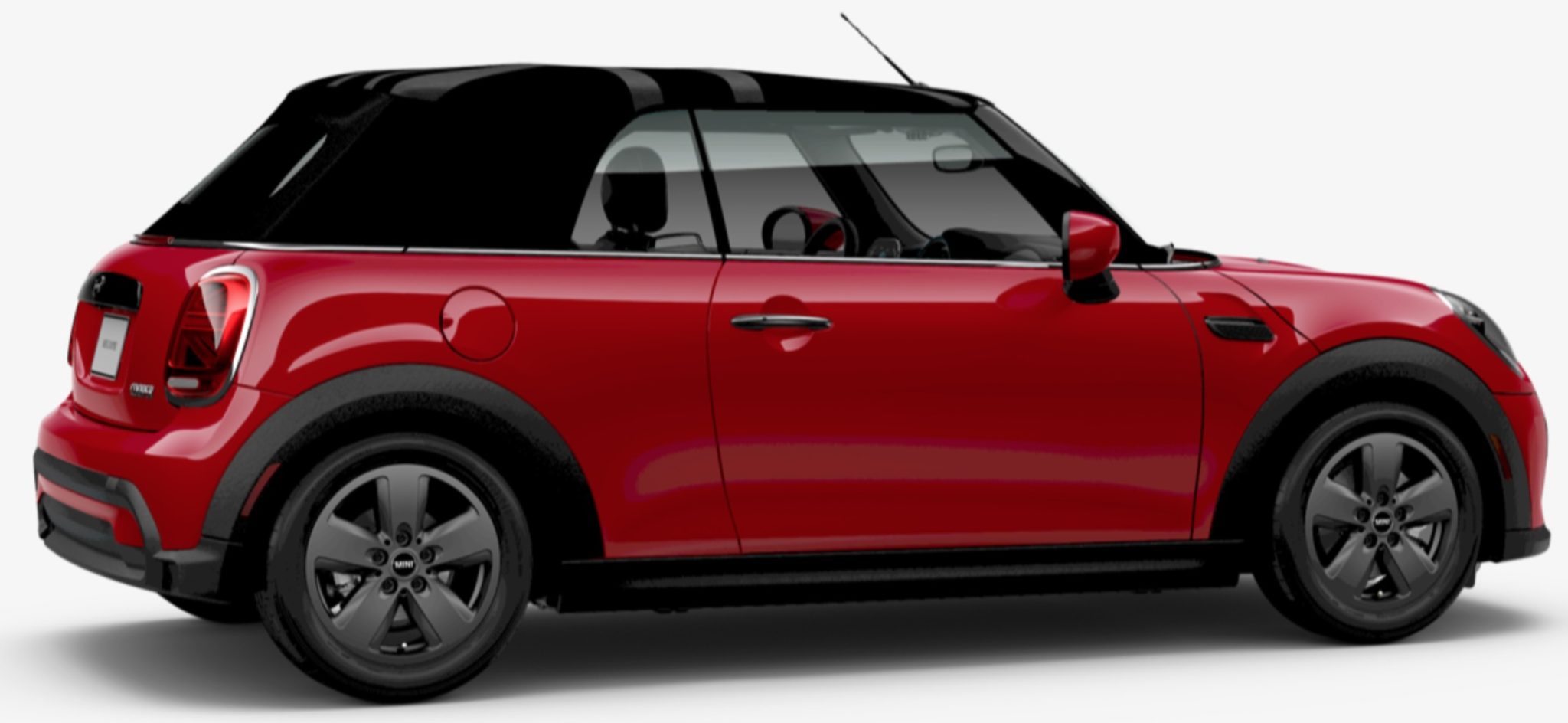
Since the front-wheel-drive Mini Cooper convertible starts around my target price of $28,750 with a 6-speed manual in base model form, I felt it shouldn’t be overlooked. I was surprised to learn the base model comes with a turbocharged 3-cylinder engine that produces 134 hp. After some research, I realized there are six other vehicles currently offered in the U.S. market with 3-cylinders. Knowing that, the base engine doesn’t seem so bad – but still, even Chevrolet’s microbox economy Spark model is equipped with a 4-cylinder.
According to specifications, this engine makes its peak torque (162 lbs/ft) at only 1,250 rpms. Since the 3-cylinder convertible tips the scales at a relatively lightweight 2,892 pounds, it should have some pep off the line in around-town driving. Its zero-to-sixty time of 8.2 seconds is, however, unremarkable by today’s standards.
Red paint is a $500 extra-cost option, and standard wheels are basic 15-inchers with non run- flat tires. If you want larger wheels with run-flats, then you’re required to move up to more expensive trim levels. Similarly, you’re also stuck with a black leatherette interior if you want the 3-cylinder. No NAV system is available on the base model. If I escaped the temptation to order individual options such as heated seats, upgraded stereo, self-parking and even a cool- looking British flag convertible top, the bottom line with delivery comes to $29,250.
If you want more power, stepping up to the COOPER S mid-level model starts your running tab at $32,750. In return, you get a 189-horse 4-cylinder turbo that delivers a more respectable zero-to-sixty blast of 6.7 seconds. Larger 16-inch wheels are standard; however, you can’t choose from other interiors, paint color variations, or larger 17- or 18- inch wheels without checking the box on a $4,000 Signature Trim package.
Red paint still adds $500 to the bottom line. Skip the Premium package ($1,250) and Signature Upholstery package ($2,000) which don’t seem worth the cost, and the bottom line for the Cooper S is $33,250.

At first, it might be easy to assume that the Chevrolet Camaro and Ford Mustang don’t belong on a list of sports (or “sporty”) cars because, well, being muscle cars with powerful V8s has been their whole reason for existence since the 1960s, right? That could be argued, since 4- cylinders have been offered off and on in Mustangs since 1974 and Camaros since 1982.
As far as the current generation goes, when you consider that base convertible versions of both models offer turbo 4-cylinder engines which are more powerful than 2.0-liter turbo engines found in 2-seat sports cars from BMW (255 hp), Mercedes (255 hp), and Audi (261 hp), it seems only fair to consider grouping them together with sports cars. Or at least, sporty cars from other continents – particularly German ones. Most importantly, the Camaro and Mustang are available with manual transmissions and feature rear-wheel-drive.
More interesting is the fact that, at curb weights of just over 3,600 pounds, Camaro and Mustang ragtops are actually closer to the weight of the pure 2-seat, manual-transmission German sports cars such as the Audi TT convertible (3,400 pounds), BMW Z4 (3,287 pounds), recently discontinued Mercedes SLC (3,384 pounds), Porsche Boxster (3,205), and Porsche 911 (3,614) than they are to the average of popular German 4-seat convertible models of comparable size.
Taking a closer look at those 4-seaters with 4-cylinders, we find automatic transmissions are the only choice in the U.S. market. So equipped, the Audi A5 convertible (AWD) weighs in at 4,045 pounds, the BMW 4-series convertible (RWD) tips the scales at 3,918 pounds, and the Mercedes C-class convertible (RWD) crushes the Earth at 4,204 pounds. In comparison, manual transmission Camaro and Mustangs are hundreds of pounds lighter. With less engine and transmission mass up front and manual transmission availability, the Camaro and Mustang get pretty close to a 50/50 front-rear weight distribution – earning them an equal spot with imports on the “sporty” cars list.
On Chevrolet’s website, I configured my Camaro in 1LT base trim which currently starts at $32,695. Red paint is no extra charge, and 18-inch wheels are standard. I’m perfectly happy with these smaller wheels and taller sidewalls on the tires, a choice made easier by the fact that factory 20-inchers are priced really high. I’m fine with skipping the exterior decoration packages ranging from $795 to $5,000 because they seem to be more flash than substance. Opting only for the $100 engine block heater, my lowest-possible MSRP is $32,795.
Ford’s EcoBoost (turbo) 4-cylinder convertible starts at $33,900 with 17-inch wheels standard. 18-inch rims can be ordered for $2,200 (and up for larger packages), and the red paint of my choice brings no price increase. Like the Camaro, the Mustang is well-equipped enough so that not that many options are really necessary. With a $150 engine block heater, my out-the-door MSRP is $34,050.

Enzo Ferrari gets credit for saying, in the early 1960s, “A Jeep is the only true American sports car”.
Enzo Ferrari gets credit for saying, in the early 1960s, that a Jeep is the only true American sports car. Whether or not he actually said it and whether or not the comment was meant as a wisecrack or a compliment could be argued, but it brings up a good point. Thinking back on my own experiences driving Jeep CJs and Wranglers with a manual transmission and torquey V6 over the decades, it’s not a stretch to think of a 2-door Wrangler as a sports car in certain ways.
Sure, they can tip over, but with a relatively wide stance, short wheelbase, and strong V6 engine, a current-generation JL Wrangler will accelerate briskly and handle pretty well until the point where it doesn’t. I know this thanks to my own recent experience driving one. Jeeps can really add sport and fun to the equation of off-roading, something the previous cars on this list cannot claim.
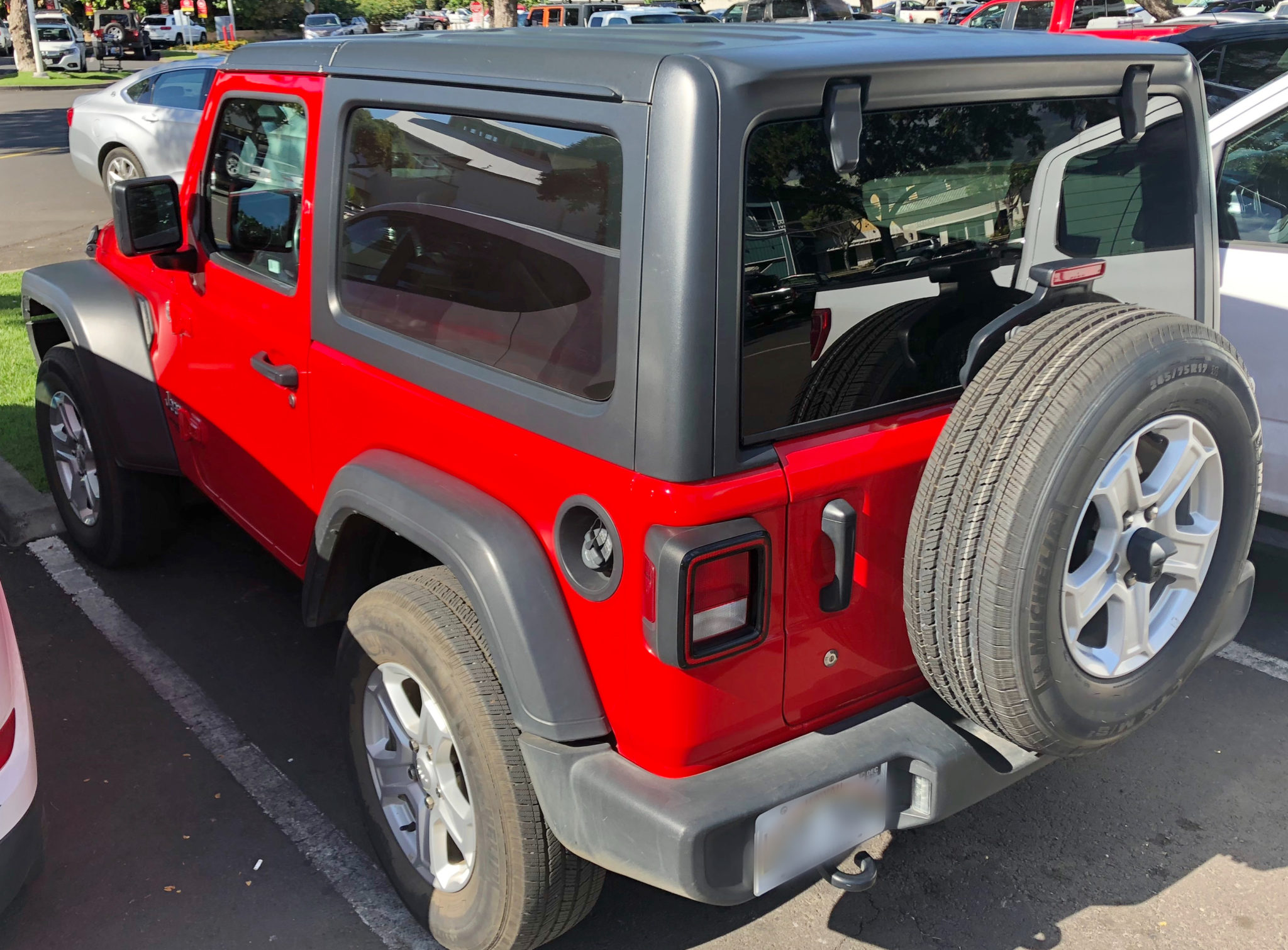
After renting this 2-door Jeep Wrangler on vacation recently, it ended up changing my opinion of what an enjoyable “red sports car” might be.Unlike the Ford Bronco, the hard top roof seen here on my rental is an extra-cost item on lower-end Wranglers.
When it comes to pricing, it’s interesting to note that the 2-door Wrangler Sport (the base model trim level) starts at my ideal price target of $29,995. Want the lowest-price 4-door model? That will cost you $3,360 more. Selecting any other color than white adds $295 (or 1%) to the bottom line – but since I want red, I’ll have to go along and allow my pocket to be picked.
The factory base wheels and tires in black are fine with me, as is the black soft-top. If I was using this for normal everyday use, I might want the $1,600 hard top. But if it’s a weekend vehicle, the standard soft top seems more befitting of a red 2-door sports car. Optional graphics, window tint, gas cap finish, stainless steel door guards, and slightly larger display screen – don’t need ‘em.
Air conditioning is $1,400, which is always worth having. Across the board, the naturally aspirated gasoline V6 engine is the only one available with a manual transmission – fine with me because it’s the standard motor, and the one I’d choose because it’s got gobs of torque. An anti-slip differential is $600, but I’ll skip that since I may want to smoke the rear tires now and then.
In red, with the soft top and air conditioning, the final MSRP is $31,690.

The 2022 Ford Bronco, as seen here in base trim with plain steel wheels.
For their new Bronco, Ford has borrowed a page from the Jeep Wrangler pricing book. A 2-door base model starts at $30,800, and a 4-door starts at $34,700. The Bronco’s standard engine is a 2.3-liter turbocharged 4-cylinder rated for 300 horsepower, and the only one available with a 7- speed manual. For $1,900 extra, a 2.7-liter twin-turbo V6 producing 330 horses and 28% more torque is available with a 10-speed automatic transmission only. As of this writing, no dealers in my area had any Broncos to use for test drive purposes, so I can’t make any seat-of-the-pants comparisons to the Wrangler.
In addition to a slightly lower price, the base Bronco comes standard with a removable hard top and doors, and Ford only charges $295 more for two optional colors. Unlike Jeep, the red I’d choose doesn’t cost extra. Since a built-in engine block heater is offered, I’ll opt for that $100 feature. Unfortunately, the only interior color choice on the base is dark gray. With the Wrangler, a tan interior was a no-cost alternative to the standard dark gray/black. Include delivery charges, and the MSRP comes to $31,395, roughly the same as a comparable Wrangler I’d order.
Base model pricing for all six choices here is so close that it’s not really a factor. Making the decision even harder is the fact that I like all of them, each for different reasons. Before this exercise, I never imagined a 2-door Jeep Wrangler as a red sports convertible. But since base versions of the Wrangler and Ford Bronco feature part-time 4-wheel-drive systems that normally operate in rear-wheel-drive mode, that’s more of a sports car feel than the front-wheel-drive Mini could possibly deliver. By skipping optional anti-slip differentials, I’ll still be able to smoke the rear tires once in awhile should the mood hit.
As of this writing, we’re deciding on a would-be choice. Any and all factors considered, which one would YOU choose?
–Sean

































